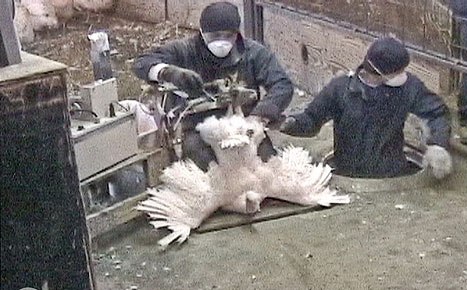Turkey Breeding
Sex determination: Sex determination is not easy in turkey. However, following methods are generally used for the same:
-
Vent Sexing at the time of hatching
-
By weight - Males are heavier to females
-
Matured male of all species have conspicuous black bearing attached to the skin of the upper region.
-
Dewbill or snood, a fleshy protuberance near base of the beak- It is relatively large, plump and elastic in males and small , thin and elastic in females.
-
Male sturt even at day-old age and continue to do so throughout their life- Sturting is not seen in females.
Reproductive parameters
Age of laying |
24 - 28 weeks |
No. of eggs produced per year |
70 - 100 |
Egg weight |
85 gm app. |
Incubation Period |
28 days |
Male female Ratio |
1 : 5 |
No of chicks per female |
43 - 63 |
Natural mating: The mating behavior of tom is known as Strut, wherein it spreads the wings and makes a peculiar sound frequently. In natural mating the male; female ratio is 1:5 for medium type turkeys and 1:3 for large types. On an average 40-50 poults is expected form each breeder hen. Toms are rarely used for mating after first year due to reduced fertility. There is a tendency in toms to develop affinity towards a particular female, so we have to change the toms for every 15 days.
Artificial insemination: The advantage of artificial insemination is to maintain high fertility from turkey flock through out the season.
Collection of semen
-
The age of tom should be 32-36 weeks for semen collection.
-
The tom should be kept in isolation at least 15 days before semen collection.
-
The tom should be handled regularly and the time required to collect the semen is 2 minutes.
-
As the toms are sensitive to handling, the same operator should be used to get maximum volume of semen.
-
Average semen volume is 0.15 to 0.30ml.
-
Use the semen within one hour of collection.
-
Take the collection three times weekly or on alternative days.Poultry:: Turkey:: Breeding
Insemination in hens
-
Artificial insemination is done when the flock attains 8-10% egg production.
-
Inseminate the hens every three weeks with 0.025-0.030ml of undiluted semen.
-
After 12 weeks of the season it may be better to inseminate every fortnight.
-
Inseminate the hen after 5-6’ O clock in the evening.• The average fertility should be 80-85% over a 16 week breeding season.

AI in Turkey
Management Practices in turkey
Incubation:
The incubation period is 28 days in turkey. There are two methods of incubation.
(a) Natural incubation with broody hens:
Naturally turkeys are good brooders and the broody hen can hatch 10-15 numbers of eggs. Only clean eggs with good eggshell and shape should be placed for brooding to get 60-80% hatchability and healthy poults.
(b) Artificial Incubation:
In artificial incubation, eggs are hatched with the help of incubators. The temperature and relative humidity in setter and hatcher are as follows:
Group |
Temperature (degree F) |
Relative humidity (%) |
Setter |
99.5 |
61-63 |
Hatcher |
99.5 |
85-90 |
Egg should be turned at hourly intervals daily. Eggs should be collected frequently to prevent soiling and breakage and also to get better hatchability.
Brooding
In turkey 0-4 weeks period is called as brooding period. However, in winter brooding period is extended up to 56 weeks. As a thumb rule the turkey poults need double hover space as compared to chicken. Brooding day old poults can be done using infra red bulbs or gas brooder and traditional brooding systems.
Points to be noted during brooding:
-
The floor space requirement for 0-4 weeks is 1.5 sq.ft. Per bird.
-
The brooder house should be made ready at least two days before the arrival of poults.
-
The litter material should be spread in a circular manner with a diameter of 2 meters.
-
Poult guard of atleast 1 feet height must be provided to prevent the poults from wandering away from source of heat.
-
Starting temperature is 95°F followed by weekly reduction of 5°F per week up to 4 weeks of age
-
Shallow water should be used.
Turkeys are not the best starters in their life and will really need some tender loving care to get them safely through the first four weeks of life. The average mortality rate is 6-10% during this period. Young poults by nature are reluctant to eat and drink in the first few days of life, primarily because of bad eyesight and nervousness. Hence, they have to be force fed.
Force Feeding:
Starve out problem is one of the major factors for early mortality in poults. So special care has to be taken for supplying feed and water. In force feeding, milk should be fed at the rate of 100ml per liter of water and one boiled egg have to be given at the rate of one per 10 poults up to fifteen days and that will compensate the protein and energy requirements of the poults.
Poults can be attracted to the feed by gentle tapping of the container with the fingers. Colored marbles or pebbles placed in feeders and water will also attract poults towards them. Since turkeys are fond of greens, some chopped green leaves should also be added to the feed to improve the feed intake. Also colored egg fillers can be used for the first 2 days as feeders.
Litter materials:
The common litter materials used for brooding are wood shavings saw dust, paddy husk, chopped saw etc. The thickness of the litter material should be 2 inch at the beginning and may be increased to 3-4 inch in course oftime by gradual addition. The litter should be raked at frequent intervals to prevent caking.
(Source: Farm Digest, Canara Bank(July-September,2008)
| 
